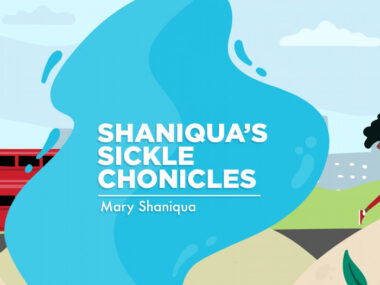Risk of blood clots more likely with sickle cell trait, but still low
SCT not limited to Black people, researchers say
Written by |

People with sickle cell trait (SCT), those who carry a mutation in one copy of the HBB gene but do not have sickle cell disease (SCD), are at an increased risk of blood clots compared with people who don’t carry the trait regardless of racial or ethnic background, according to a study.
Still, the researchers said, the risk of these blood clots was low, occurring in just over 2% of people carrying SCT.
The study, “Ancestry-Independent Risk of Venous Thromboembolism in Individuals with Sickle Cell Trait vs. Factor V Leiden,” was published in Blood Advances.
“I hope this study informs health professionals, particularly hematologists, that when thinking about risks related to SCT, they need to be looking at all populations, not just one group,” Vence L. Bonham Jr., acting deputy director of the National Human Genome Research Institute and a study author, said in a press release from the American Society of Hematology. “SCT is understudied, and this is an area of opportunity for more research,” Bonham said.
SCD is caused by mutations in both copies of the HBB gene, leading to the production of an abnormal version of hemoglobin, the protein that helps red blood cells carry oxygen. People who carry only one mutated HBB gene copy are considered to have SCT. Also known as sickle cell carriers, these individuals generally lead normal lives without any symptoms.
Risk of blood clots
People with SCT may be at an increased risk for venous thromboembolisms (VTE), when a blood clot forms in a vein. This may include pulmonary embolism, in which a clot forms in the lungs, or deep vein thrombosis, in which the clot forms in deep veins, often in the legs.
Previous studies on the link were largely limited to Black populations. It is often wrongfully assumed that SCT only affects Black people, leading to discrimination in research, according to the authors.
“SCT is erroneously associated only with Black individuals, even though it is found in very diverse populations,” said Rakhi Naik, MD, an associate professor at Johns Hopkins University and the study’s senior author. “When we do research within a specific population, we often make the incorrect assumption that the genetic trait is found only in that population, even though it is found quite broadly.”
A similar bias is seen with heterozygous factor V Leiden (FVL), the most common inherited blood clotting disease, which is often assumed to affect only white people, the researchers said.
They decided to conduct a large analysis of VTE in people with sickle cell trait and FVL, regardless of race or ethnicity. They leveraged genetic data from 23andMe, using DNA samples from more than 4 million adults who submitted self-reported data about their history of VTE.
Results showed that the prevalence of sickle cell trait in this group was 0.46%, affecting just over 19,000 people, with the highest prevalence in people of African ancestry (7%), Latino ancestry (0.67%), and South Asian ancestry (0.16%). The prevalence of FVL was 4.45%, affecting more than 186,000 people.
A history of VTE was reported by 2.57% of people with SCT, compared with 2.25% in people without it. Among those with FVL, VTE was reported by 6.93%, compared with 2.04% in those without FVL.
In final statistical analyses, the risk of VTE was found to be 1.45 times higher in people with sickle cell trait relative to those without it, regardless of race or ethnicity. Still, the risk of VTE was even higher in people with FVL, who were 3.3 times more likely to experience VTE than those without FVL.
Unique clotting mechanism
The most common type of VTE experienced in people with SCT was a pulmonary embolism, whereas deep vein thrombosis predominated in FVL.
This difference “points to a unique mechanism of clotting in SCT, which warrants further research,” Naik said.
The researchers said they hope the findings inform better clinical practice guidelines for SCT management. “Very few clinicians know how to counsel someone with SCT,” Naik said. “This study shows that SCT in itself is not a disease. It’s a risk factor like FVL, and the risk is still very small.”
Study limitations were the fact that VTE information was self-reported, and that data on other factors, such as surgery or injury, that could provoke blood clots were not available.
“Our study provides important ancestry-independent risk estimates for VTE in individuals with SCT,” the researchers wrote. “These data may inform clinical practice guidelines, future research, and public health initiatives in SCT,” they added.







